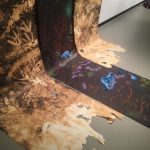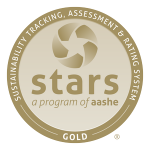H2CO3 is a two-dimensional piece depicting the degradation of coral reefs. The piece consists of three panels of detailed drawings of healthy, bleached, and algal corals descending down the paper. On two panels, the corals are met with abstract markings made by household bleach and distress from sandpaper towards the bottom. The paper is black not only so the bleaching is visible but also to make the connection that ocean acidification and coral bleaching are really effects of increased atmospheric carbon caused by anthropogenic activity (carbon is traditionally depicted as black). Each strip can stand in place of many coral reefs, the outermost in poorest health— like the Great Barrier Reef and Hawaiian Reefs— and the inner one of the remaining reefs in good health— like Indonesian Reefs. Additionally, the evolution and processes I use in this piece is meaningful. I initially drew in healthy corals followed by gradually increasing introductions of bleach and bleached corals in a pace similar to the Keeling curve. Both the method and the details of the piece portray the effect of anthropogenic climate change on coral reefs.
This piece can be connected to Anthropogenic rhetoric in Eco Art, an art movement informed by contemporary environmental issues and social justice. Visually, the use of size in Eco Art pieces is a formal quality most often utilized. As a result, the scale of my piece is inspired by others that use size as a projection of the large-scale of the environmental damage being surveyed. My past work has been a gradual incline to the investigation of environmental issues. I have mostly had a focus in projects based around people and the communication of displaced environmental degradation. Last year, I created an installation, Carbon Cube, to similarly draw attention to an environmental issue that can seem abstract. In that piece I was giving an abstract atmospheric emission a concrete form to bridge daily human activity and environmental impact. With this project, I am bridging the gap between the daily human activity and a displaced impact.
The content I have chosen, though explored by other artists, is unique because I don’t approach it from a perspective that seldom highlights the aesthetic value of a reef. Though aesthetic, social values are capable of emotionally seducing viewers I wanted to portray the intrinsic value of ocean health as well. By connecting humans to the health of ecosystems so far from their daily lives, the piece minimizes space between them. This emphasizes not only the need for humans to fix this issue but that we are complicit as well. Formally, the incorporation of bleach as a mode of mark making is a fairly unique method. I wanted to connect the content and form by mimicking the removal of the color of healthy corals by stripping the paper of its original color. The paper is tall to mimic the vastness of the ocean ecosystem and our effect on it. Additionally, the paper will extend out onto the floor to invite the viewer to consider their impact on the issue. Viewers will interact with the piece spatially and hopefully will consider their own “footprint”.
The most important idea I want to communicate to the viewer is that their daily actions and lifestyles do have an impact. More importantly, I want to show that the degradation of these ecosystems is not directly attributed to their surrounding countries. The issue is due to a global increase in outputs of CO2. This piece is meant to serve as a reminder that our actions have a bigger effect outside of our ecosystem and are harshly affecting oceanic systems. The piece is not meant to serve as an answer or solution but to place the responsibility for the damage on humans, a responsibility that so many deny.
Come to Clifford Gallery to see all the art theses! The exhibit will be open from December 13-February 14th.








 Last week, Colgate University received a STARS Gold rating for the second time with its highest ever score (72.19) from the Association for the Advancement of Sustainability in Higher Education (AASHE).
Last week, Colgate University received a STARS Gold rating for the second time with its highest ever score (72.19) from the Association for the Advancement of Sustainability in Higher Education (AASHE).
